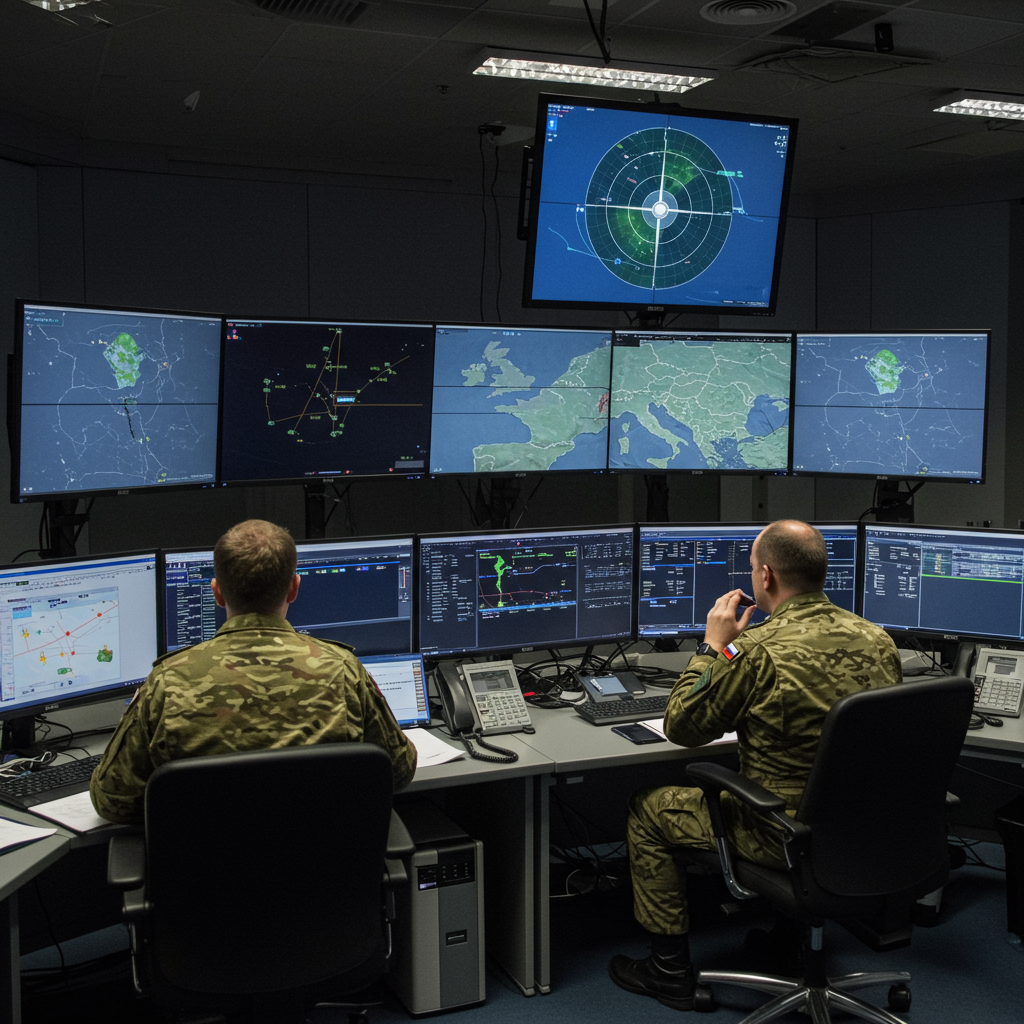NATO has launched a critical new initiative, dubbed “Eastern Sentry,” significantly boosting the defense capabilities of its eastern flank. This urgent response follows a series of alarming Russian drone incursions into Polish airspace, underscoring escalating tensions and the need for enhanced readiness. The operation signals NATO’s unwavering commitment to collective defense, sending a clear message that any violation of allied territory will be met with a swift and robust response. This comprehensive security measure aims to bolster air and ground defenses across the entire eastern border, from the High North to the Black Sea.
Escalating Tensions: Russia’s Reckless Airspace Violations
Russian drone activity near and within NATO airspace has seen a worrying increase, moving beyond isolated incidents to a pattern of what officials describe as dangerous recklessness. Most recently, a Russian drone incursion into Polish airspace prompted immediate action from the alliance. NATO Secretary General Mark Rutte condemned the “dangerous and unacceptable” incident, highlighting that Russia’s airborne provocations along the eastern flank are becoming more frequent and concerning. These actions are viewed not as mistakes but as deliberate challenges to NATO’s sovereignty and stability.
Poland Under Fire: An Intentional “Attack”
Polish Prime Minister Donald Tusk vehemently declared that the drone incursion into his country was an “attack” and not an accident. This firm stance directly countered suggestions that the airspace violation could have been unintentional. Polish officials reported that as many as 21 drones were launched, with 16 found across hundreds of square miles of territory. Many of these intrusions originated from Belarus, further complicating the geopolitical landscape. The scattered debris indicates a broad and aggressive pattern, reinforcing the Polish government’s assessment of an intentional act aimed at probing and intimidating.
Introducing “Eastern Sentry”: A Robust Defensive Shield
The “Eastern Sentry” operation is NATO’s decisive answer to these evolving threats. Announced by Secretary General Mark Rutte, this initiative will commence immediately, leveraging substantial assets and strategic coordination from multiple allied nations. Its core objective is to strengthen NATO’s defensive posture, ensuring the alliance is perpetually ready to defend “every inch of its territory.” The operation is designed to be highly flexible and agile, allowing for rapid adjustments to emerging threats.
Allied Contributions and Enhanced Capabilities
The “Eastern Sentry” operation benefits from a significant commitment of resources and expertise from several key NATO members. Denmark, France, the United Kingdom, and Germany are among the nations dedicating critical assets to this defensive effort. Specific contributions include:
Denmark: Two F-16 fighter jets and an anti-air warfare frigate.
France: Three advanced Rafale fighter jets.
- Germany: Four state-of-the-art Eurofighter aircraft.
These assets will be integrated into a sophisticated defense network that includes enhanced air and ground-based capabilities, alongside increased information-sharing protocols among NATO partners. US General Alexus Grynkewich, NATO’s Supreme Allied Commander Europe, emphasized that while the full scope of the operation will take time to materialize, initial steps are already underway. This integrated approach ensures a layered defense, combining aerial surveillance, rapid intercept capabilities, and coordinated ground-based responses.
Strategic Reach: From the High North to the Black Sea
The strategic importance of “Eastern Sentry” extends beyond the immediate focus on Poland. General Grynkewich underscored that the situation “transcends the border of one nation,” reinforcing the principle that an attack on one ally is an attack on all. This operation will encompass the entire eastern flank of NATO states, stretching geographically “from the high north to the Black Sea and the Mediterranean.” This vast coverage demonstrates a comprehensive commitment to regional security.
Adapting to Emerging Threats
A cornerstone of “Eastern Sentry” is its adaptability. NATO intends to constantly adjust and change its posture across the eastern flank, aiming to keep potential adversaries off guard while responding effectively to specific threats as they emerge. This dynamic strategy is crucial in countering unpredictable and hybrid warfare tactics, such as drone incursions, which often exploit perceived weaknesses or slow response times. The lessons learned from previous operations, like the “Baltic Sentry” launched in response to cable sabotage in the Baltic Sea, are being applied to refine this flexible approach. This proactive stance ensures that NATO remains one step ahead, continually optimizing its defense strategies.
Reassurance and Resolve: Upholding Collective Security
For citizens across the Alliance, particularly those residing on the eastern flank, “Eastern Sentry” offers a powerful message of reassurance. NATO’s rapid response to the recent drone incidents and the subsequent launch of this operation unequivocally demonstrate the alliance’s resolve. Secretary General Rutte affirmed that regardless of whether Russia’s actions are deemed deliberate, violating NATO airspace demands a clear show of strength and capability. NATO Eastern Sentry Operation is specifically designed to articulate this resolve, safeguarding allied territory and deterring further aggression. This initiative reaffirms NATO’s core mission of collective defense and its enduring commitment to peace and security in Europe.
The Broader Geopolitical Context
The launch of “Eastern Sentry” occurs within a complex geopolitical environment. Ongoing military activities near NATO borders and increasing rhetoric underscore the fragile security situation. This operation is not merely a tactical response but a strategic statement about the inviolability of NATO borders and the unity of its members. By integrating advanced air defense systems and fostering greater interoperability, NATO aims to deter future provocations and maintain regional stability. The alliance understands that demonstrating strength and readiness is paramount in the current international climate.
Frequently Asked Questions
What is the “Eastern Sentry” operation and why was it launched?
The “Eastern Sentry” operation is a new, urgent NATO initiative designed to reinforce the defense of Europe’s eastern flank. It was launched in direct response to an increasing frequency of Russian drone incursions, most notably a recent incident involving multiple Russian drones violating Polish airspace. NATO Secretary General Mark Rutte described these incursions as “dangerous and unacceptable,” prompting the alliance to boost its readiness and make clear its capability to defend its territory against such provocations, which Polish officials termed an intentional “attack.”
Which NATO countries are contributing assets to the “Eastern Sentry” operation?
Several key NATO member states are dedicating significant military assets to the “Eastern Sentry” operation. These include Denmark, which is contributing two F-16 fighter jets and an anti-air warfare frigate; France, providing three advanced Rafale fighter jets; and Germany, deploying four Eurofighter aircraft. Other allied nations are also expected to contribute, forming an integrated and flexible defensive posture across the entire eastern flank, enhancing both air and ground-based defenses.
How does “Eastern Sentry” enhance NATO’s collective defense strategy against future threats?
“Eastern Sentry” significantly enhances NATO’s collective defense strategy by providing a more flexible, agile, and robust posture across its eastern flank, from the High North to the Black Sea. It integrates enhanced air and ground-based defenses with increased information-sharing among allies, allowing for quicker detection and response to threats like drone incursions. This operation makes clear that an attack on one ally affects all, reinforcing the principle of collective security and deterring potential adversaries by demonstrating NATO’s immediate readiness and capability to defend “every inch of its territory.”
Conclusion
The launch of NATO’s “Eastern Sentry” operation marks a pivotal moment in the alliance’s ongoing efforts to secure its borders and deter aggression. Prompted by increasing Russian drone activity and deliberate airspace violations, this initiative underscores NATO’s unwavering commitment to collective defense. By integrating cutting-edge assets from multiple member states and adopting an agile defensive posture, NATO is sending an unambiguous message: its territory is inviolable, and its allies stand united. This operation not only bolsters immediate security but also strengthens the long-term stability of Europe’s eastern flank, ensuring readiness against evolving geopolitical challenges.


